According to statistics, 50 to 70% of warehouse operational costs are consumed by labour, and almost 50% is accounted for order picking.
However, an efficient order picking process that includes a well-prepared pick list can significantly reduce the overhead expenses during fulfilment.
Pick lists are an essential part of your eCommerce order fulfilment process and act as catalysts for the success of your brand.
If your pick lists are prone to error, you’ll end up delivering the wrong products to the customers. Plus, you’ll have to bear the costs of reverse logistics and it may shrink your profit margins.
On the other hand, getting your pick lists right can set you on the right course and contribute to efficient warehouse management. But what does a pick list mean? Let’s get right into it:
What is a Pick List? Definitions of Pick Lists
Pick list can be defined in many different ways but in technical terms, it’s described as:
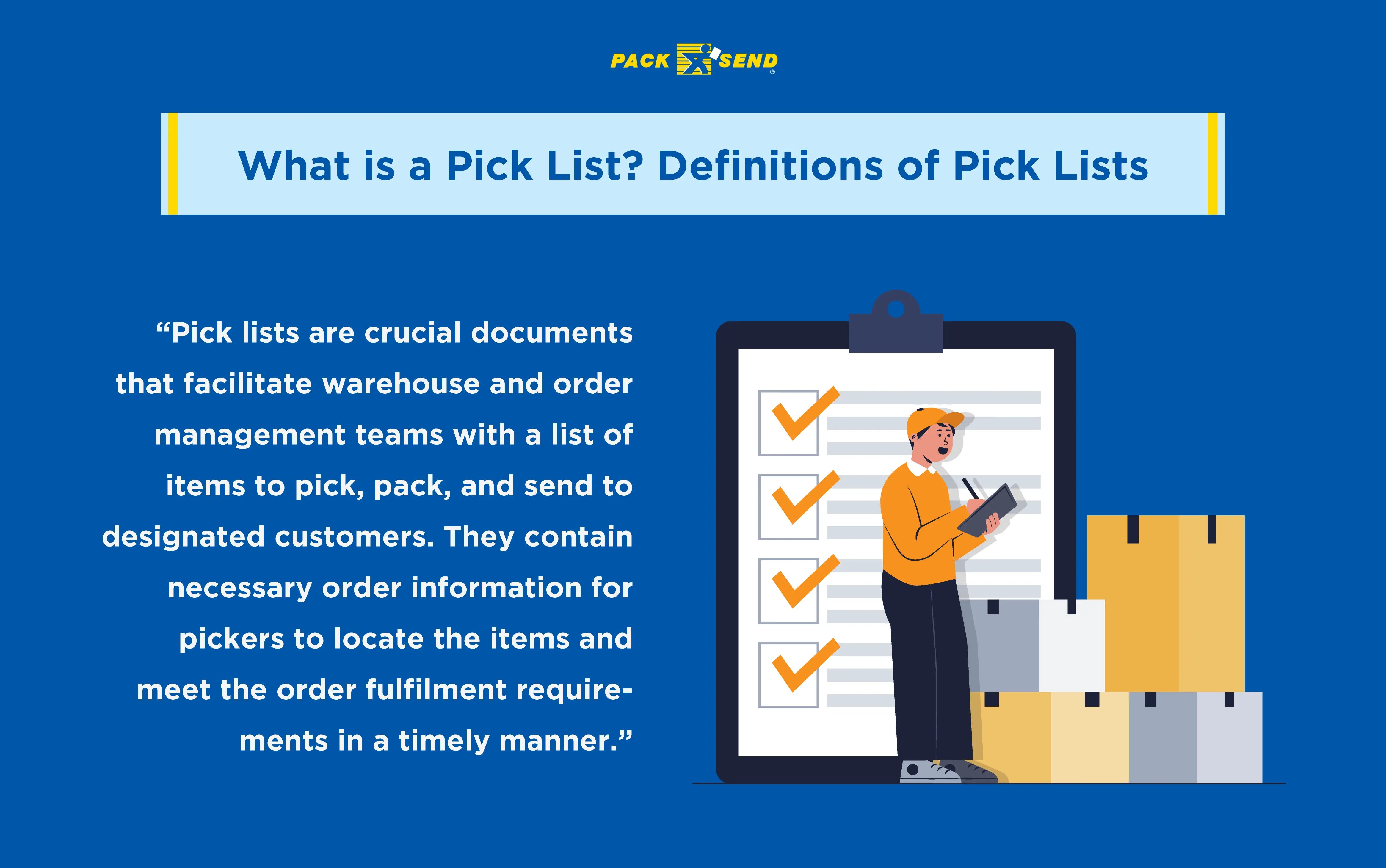
In simple terms, pick lists are vital documents that contain essential eCommerce order information for collecting and sending different items in specified quantities. Such documents are important for eCommerce businesses to fulfil orders without hassle.
Depending on the business type and size, a pick list can contain items to pick, shipment details, location in the warehouse, item/customer information, and other data. Pickers need to follow such details in exact order to dispatch items safely and successfully.
Pick lists are generated at a periodic interval during the day using an inventory management tool or manually using excel after customer orders come in.
The primary goal of generating an excel pick list is to provide pickers with all the necessary information to prepare and dispatch the order in a safe and controlled environment.
Why Does Pick List Matter for Your eCommerce Business?
One of the critical elements of running an eCommerce business that needs utmost attention is achieving customer satisfaction. One way brands can achieve it is by streamlining the order fulfilment processes from the get-go.
The process begins with customers placing orders, and ends with carriers dropping them at the customers’ doorstep. However, for an item to reach its final destination, warehouse managers have to generate a pick list and assign pickers to pick and pack items.
To carry out such an intricate process successfully, pickers need detailed and up-to-date pick lists that include product information, quantity, photo, SKU, location, and dispatch information.
Thus, picking lists are necessary to begin order processing at your warehouse. They smoothen the order picking and processing to help logistic and shipping providers to complete orders with speed and accuracy.
Apart from that let’s see some more advantages of creating a pick list:
Advantages of Creating Pick List
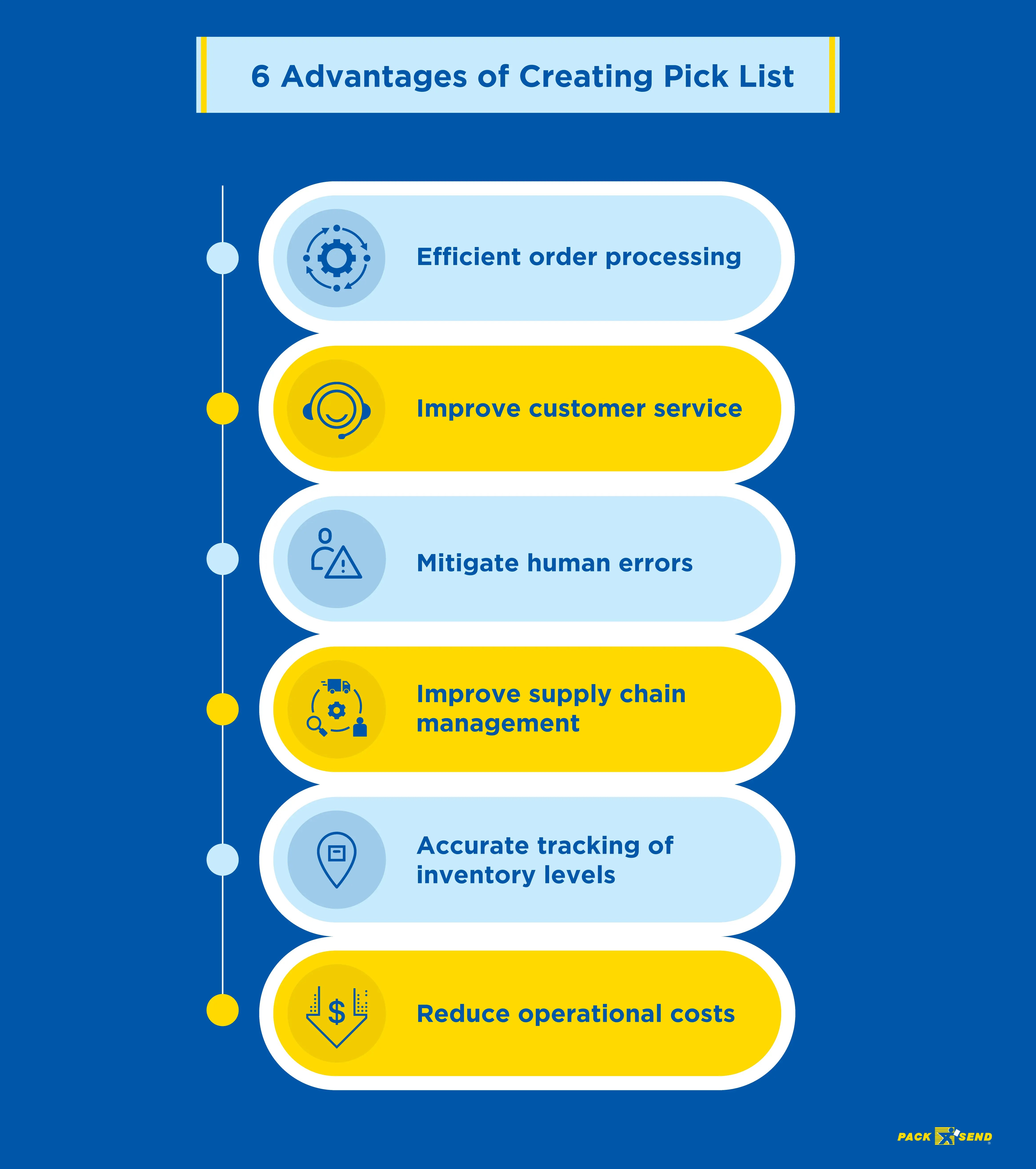
- The prime advantage of creating a pick list is to make order processing efficient on a large scale and save time in picking and packing.
- Pick lists—when implemented correctly—can lead to improved customer service and satisfaction levels.
- Pick lists reduce the chances of human error and accelerate order processing.
- Pick lists positively impact your supply chain management.
- Pick lists enable warehouse managers to maintain an accurate inventory of goods.
- They aid in the precise picking and packing of items, leading to maximum productivity and reduced operational costs.
How to Create a Pick List for Your Business?
Earlier, you had to rely on the skill sets and memory of pickers for order retrieval, which could lead to inefficient picking. But today, we have advanced warehousing technologies and inventory management systems to achieve speed and accuracy in order picking.
Pick lists are one such asset to fast-track your order retrieval and fulfilment. Creating pick sheets involves several steps as described below:
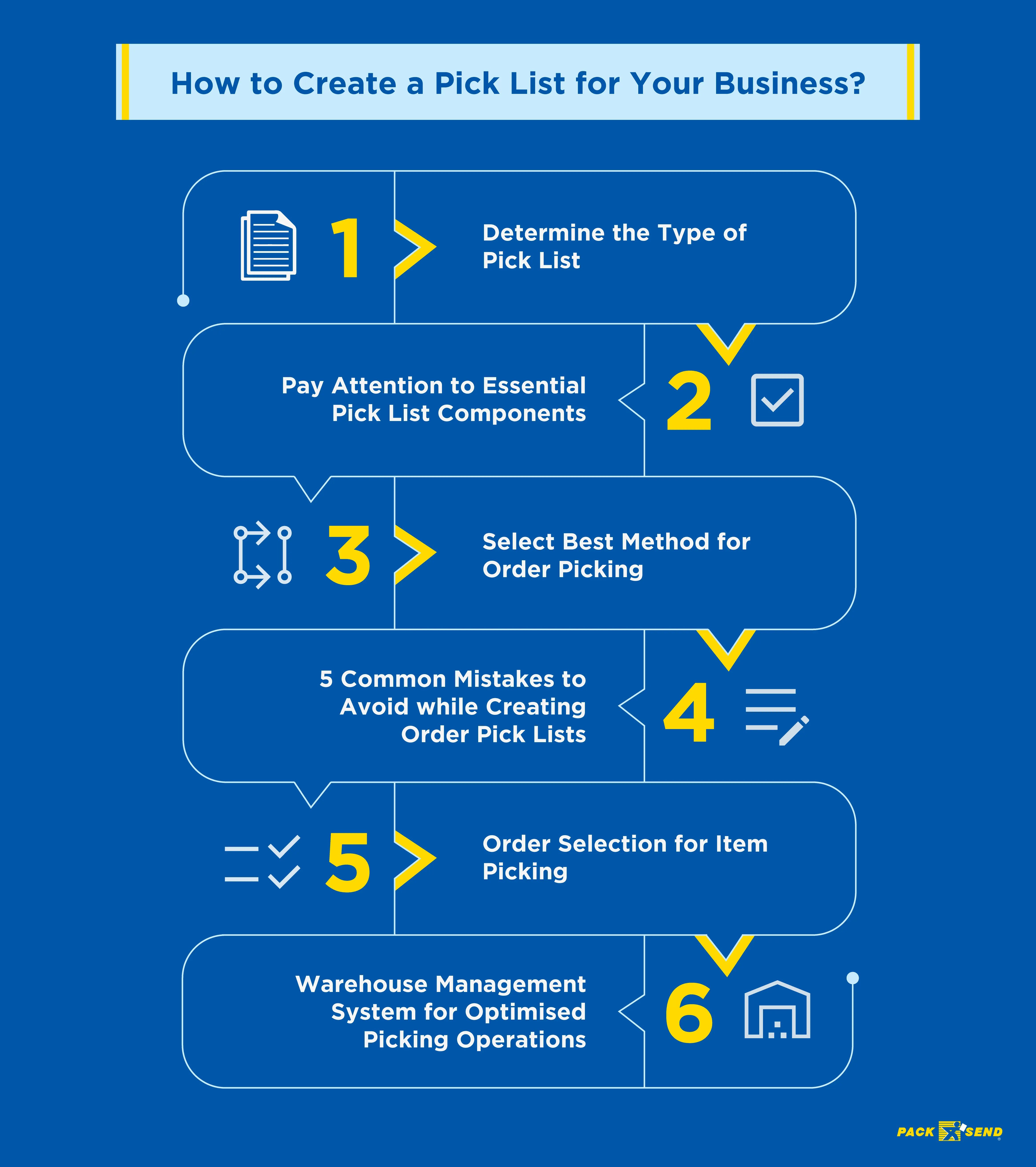
1. Determine the Type of Pick List
Choosing the suitable type of pick list depends on various elements. Still, here’s the general process of selecting one to take care of your eCommerce shipping and order fulfilment needs:
Types of Pick Lists
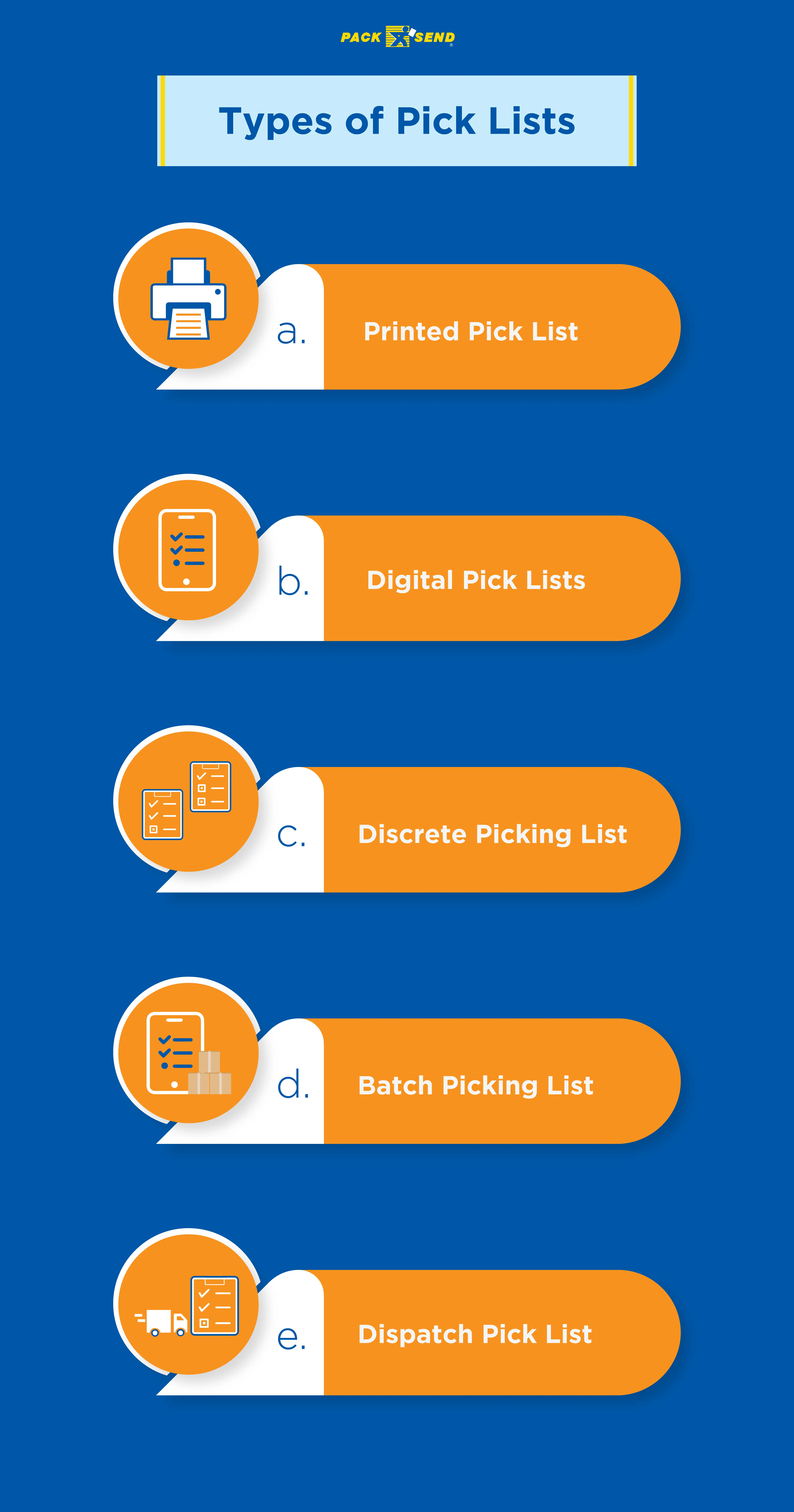
a. Printed Pick List
Also known as physical pick lists, these are generally paper printed excel pick lists handed to pickers for locating items in a warehouse. Before digital technology like WiFi or mobiles took over, warehouses used to depend on this list type.
Even today, many warehouses use this method as they are considered to be the safest bet. Plus, it’s a preferred option for most pickers as it doesn’t ask for much digital skills.
However, printed pick lists are turning out to be inefficient today due to the increased warehouse automation. Thanks to that, we got introduced to digital pick lists that increase the efficiency and productivity of pickers and reduce the operational and labour costs as well.
b. Digital Pick Lists
Digital pick lists are the modus operandi for advanced warehouses with tech-agnostic staff. Warehouses and pickers adept in using mobiles, tablets, and other digital devices prefer this type of pick list.
Slowly but steadily the world is shifting towards digital pick lists where order details are automatically updated in internet-reliant warehouses.
The pickers can follow the instructions presented on their devices and complete their picking and packing tasks more efficiently.
Another advantage of digital pick lists over printed ones is that they include product images, quality control checks, and other information for improved picking accuracy.
c. Discrete Picking List
Discrete picking lists are simple and only include products from a single purchase order. Here, the pickers are provided with a single sheet of pick list that contains multiple products pertaining to one order.
It’s one of the common pick list types as it’s easy to understand and quick to execute. Here, the item picker first picks all the items in an order and then only moves to another one.
The advantage of this pick list type is the faster response time for order fulfilment which enables you to track the accuracy of the picker. The drawback, however, is that it requires a lot of back and forth and travel time for completing orders.
d. Batch Picking List
Unlike discrete lists, batch picking lists include multiple orders that pickers need to collect on a single run. This can be either printed picking slips or digital ones provided based on the picker's preferences.
Here, the products from multiple orders are first brought to a consolidated area where they are sorted, grouped, packed, and dispatched to the designated location.
e. Dispatch Pick List
Dispatch picking lists are generally given not to picker staff but to the dispatch staff. In contrast to other types, this pick list contains the list of goods and consignments that are ready to dispatch from the warehouse.
Preparing such a picking list is essential because sometimes, certain items in the order are either out of stock or the order is cancelled just after the placement. Thus, sometimes order pick lists may vary from the dispatch lists.
How to Select a Pick List Type
The selection of pick list type should purely depend on the preferences of staff, warehouse area, and the number of orders to fulfil in a day.
For instance, if the picker staff is not familiar with digital tools, giving them digital pick lists can impact greatly on order retrieval time. Similarly, if your warehouse is large and fulfils thousands of orders a day, you’d want to use more efficient types such as digital and batch pick lists.
Each business is unique and may have several different factors into play. So, you must select a pick list type that best suits your needs and helps meet your goals efficiently.
2. Pay Attention to Essential Pick List Components
Elements in a pick list can vary depending on factors like pick list type, warehouse type, product to pick, and others. Here are some essential components to include in your picking list:
Order Information
Order information is the first vital component that should be a part of your pick list. The list must include:
- Order number
- Quantity of a product to pick
- Unit of measurement
- Size and weight
Such information enables pickers to collect the right items in the correct quantity, which they can reference back when issues arise. Using digital picking lists will give you an edge and transparency throughout the process.
Date and Time of Order Delivery
Many eCommerce stores offer their customers the luxury to get the order on the same day it was placed. Thus, including the date and time of order delivery is sometimes critical not only for order fulfilment but also to be true to your commitment.
That’s why your warehouse management team needs to take care of urgent orders based on the date and time of order delivery listed in the pick sheets.
Product Location in the Warehouse
Adding product location from where pickers can retrieve the item can be a blessing when working in large warehouses with millions of products. Not getting such information can make pickers feel exhausted. They may feel they’re finding a needle in a haystack.
Here, the guessing game to find ‘what item is stored where’ will turn out to be inefficient and time-consuming. Thus, information about where a specific item is stored in a warehouse will give pickers clarity and reduce the travel and item pick time.
Product SKU
Each product, when sorted, is assigned a Stock Keeping Unit (SKU). It’s a unique identifier allotted to products with different configurations and specifications.
For instance, 100 red t-shirts from a particular brand with the same size configuration will have the same SKU. Similarly, the SKU will change based on the price, brand, colour, style, size and other characteristics.
Without SKUs, pickers sometimes can not differentiate between similar products and mix them up with other items. That’s why SKUs are an important addition while preparing a pick list.
Product Description/Photo
Apart from SKUs, another way to differentiate similar products when picking up is by adding a description or a photo in the pick list. Adding such details in the printed version of the pick list might not be feasible but would be great for pickers with digital lists.
Having such additional information will aid pickers to retrieve the correct items and speed up the order picking and fulfilment process.
Customer Information
While adding customer information to the pick sheets may not seem relevant, but can come in handy to commence the fulfilment process. For pickers, such information is irrelevant but necessary for people involved in packing, labelling, and shipping.
It acts as a measure of quality assurance and validates the order details like customer name and shipping address. So, practice incorporating such information in your pick lists.
Pick List Number
Each picking list should have a unique number which makes it easy to find and cross-verify if the pick list has already been completed. Also, it ensures pickers do not get the same pick list multiple times.
Another advantage of the pick sheet number is you can easily find them and pull them out of your system for review and audit requirements.
3. Select Best Method for Order Picking
Next in line is to prepare orders for dispatch based on the list provided to picking staff. There are several picking methods at your disposal to choose based on the warehouse configuration and staff availability.
Here are some for you to consider:
Best Order Picking Methods
- Single-Order/Piece Picking
- Zone Picking
- Batch Picking
- Parallel Picking
- Wave Picking
- Cluster Picking
- Pick-to-Light
- Voice Picking
- Mobile Scanner Picking
- Robotics for Picking
To learn more about the above methods, read our detailed blog post on picking methods.
How to Select the Picking Method
Typically, picking methods adopted by warehouse managers vary from place to place. Also, it depends on the items to pick and the experience and expertise of the staff.
Small warehouses with a minimal product catalogue can use the piece, cluster, batch, and other suitable and simplistic methods.
However, warehouses with a large product catalogue and high over volume must use zone, parallel, wave, and other advanced picking methods for improved fulfilment.
4. 5 Common Mistakes to Avoid while Creating Order Pick Lists
As we know, picking lists are vital yet prone to many errors and challenges that can cost you time and money. To help you minimise such challenges, here we list some of them that can hinder your order fulfilment process.
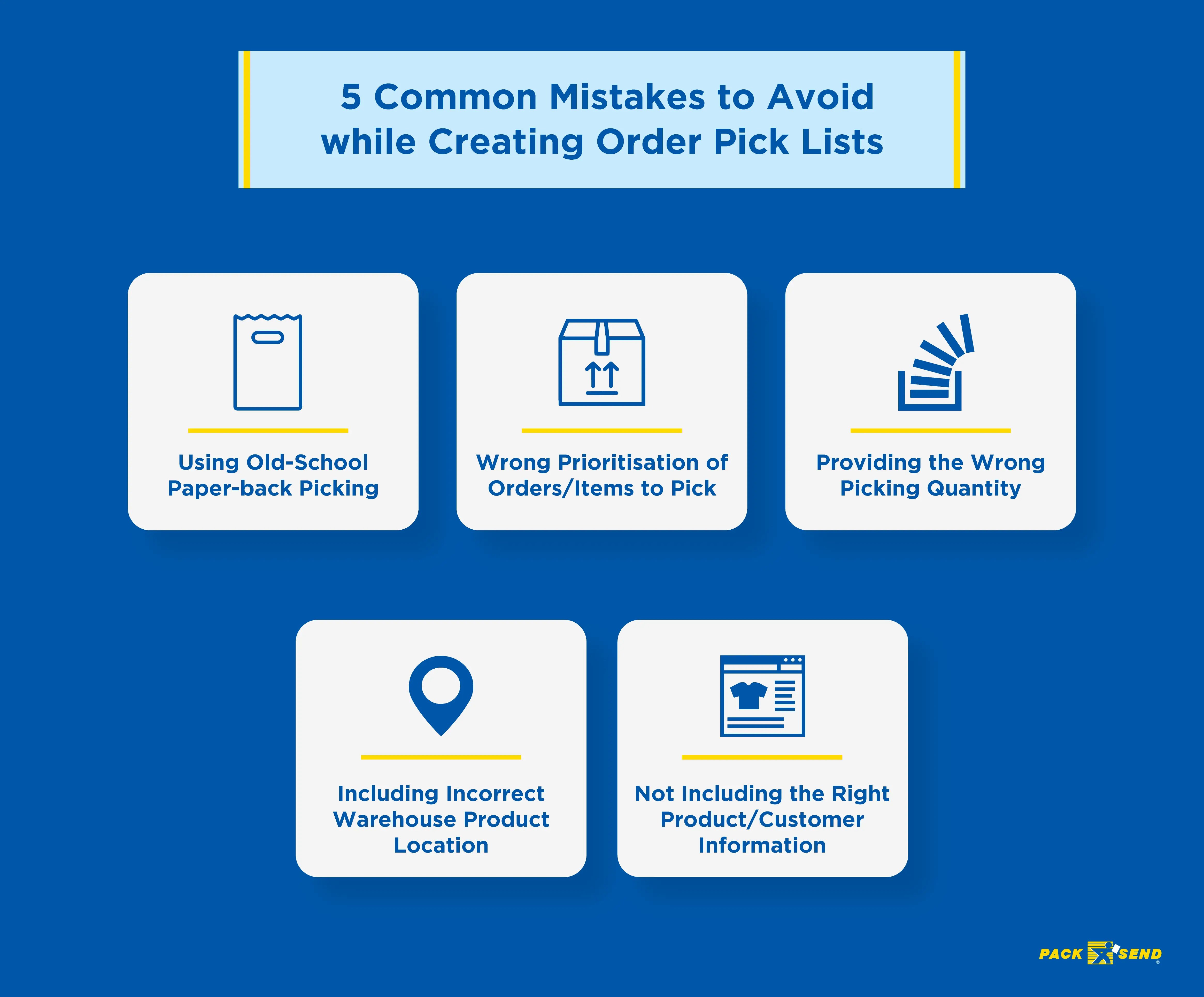
a. Using Old-School Paper-back Picking
First, preparing paper picking slips is a time-consuming process and carries chances of errors at any stage of the fulfilment process.
So, replace the paper picking slips from your warehouse and use digital methods to avoid any confusion.
b. Not Including the Right Product/Customer Information
One of the common errors is not including the right product/customer information while creating order pick lists. This may lead pickers and shippers to retrieve and deliver the wrong items to the customers.
It’ll cause dissatisfaction and inconvenience to your customers and your reputation may take a hit. To avert such a scenario, you must cross-verify your pick list items for errors at every stage. Also, you can implement an order management system to provide accurate product info.
c. Providing the Wrong Picking Quantity
If you prepare manual, hand-written, or printed picking slips, pickers can sometimes misinterpret them and pick the incorrect quantity of products. This can lead pickers to collect insufficient or additional items.
If the mistake is not realised before delivery, it can result in a bad customer experience and loss of money & reputation. But you can avoid it by implementing a mobile barcode scanning system to pick the right quantity in the first go.
e. Wrong Prioritisation of Orders/Items to Pick
Pick lists prepared without proper order/item prioritisation and in a haphazard manner can delay the orders or important orders get neglected by picking staff.
To avert such delay and customer dissatisfaction, refine your pick lists to include important and priority orders/items first.
f. Including Incorrect Warehouse Product Location
Another crucial element that creates a challenge for pickers is finding the right location of products to pick. Inaccurate or wrong mention of the warehouse location in pick lists gets pickers confused and delays the picking and subsequent operations.
Introduce and implement a pick-to-light method so that pickers can easily find the location of products in the warehouse. This will help them collect the right product without delay.
5. Order Selection for Item Picking
The three basic components of order fulfilment are picking, packing, and shipping. Pick lists are vital for fast, accurate, and easy picking and packing of items. It’s an integral part of warehouse management that helps navigate your pickers efficiently for order picking.
As we learned earlier, there are several types of pick lists and several different methods to create one. You can simply print picking slips as and when the orders arrive or you can prepare a pick list in excel.
However, with time, your eCommerce business will grow and require scaling up. It’ll require innovation for pick list creation that improves accuracy for order selection and picking.
That’s where the need for a warehouse management system is realised. By adding robust procedures for every aspect of fulfilment, you can optimise order selection and picking operations.
6. Warehouse Management System for Optimised Picking Operations
The warehouse management system plays a vital part and enables you with several capabilities and features for efficient order picking operations. So, let’s dive into some of the features it can offer:
- Devise picking strategies automatically with proper recommendations of item and bin location based on first-expired, first-out parameters.
- Automatic pick path creation for navigation to pick single and multiple orders simultaneously to cut travel times.
- Enable warehouse managers to utilise wave picking templates and assign orders to pickers based on the expected shipping date, item type, quantity, customer information, shipping method, etc.
- Automatic identification of order cluster opportunities for optimised picking of multiple orders.
Best Practices of Pick List Creation for Order Picking
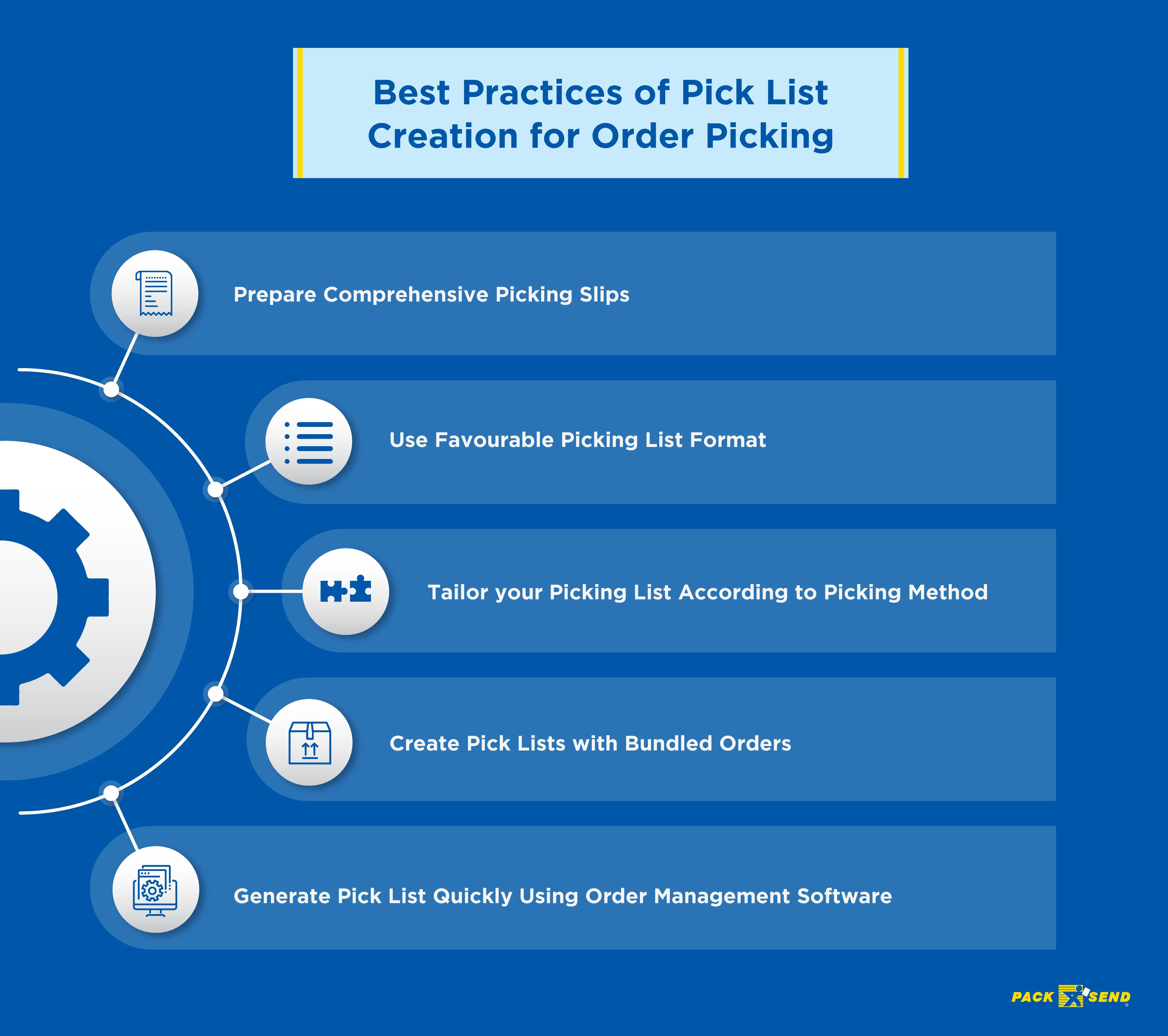
Sure, the steps mentioned above will aid you in creating an efficient pick list for highly effective order-picking workflows. Still, to make the job easier, let’s glance over some best practices for pick list creation:
a. Prepare Comprehensive Picking Slips
One of the key aspects of successful warehouse picking operations is to prepare as detailed and comprehensive pick lists as possible. Include all the necessary information and components listed above in your picking list to eliminate any confusion for pickers.
Another benefit of doing so is that pickers can easily reference back any order picking information and cross-verify before picking items.
b. Use Favourable Picking List Format
The picking list format has a significant impact on your warehouse picking operations. Some of your picking staff may only be comfortable with printed picking slips while others can work with digital ones too.
So, a pick list created keeping the comfort of your pickers in mind will aid in efficient and streamlined warehouse operations.
c. Tailor your Picking List According to Picking Method
Warehouses, specifically large-scale ones, have implemented a different combination of picking methods. Also, they receive orders in high quantity and volume that need to be addressed promptly.
This requires creating tailored picking lists for different combinations of picking methods and orders. Doing so will reduce warehouse travel time for pickers so that they can efficiently retrieve items without delay.
d. Create Pick Lists with Bundled Orders
Small-scale warehouses and product storage rooms may not have as much order volume to fulfil. Also, picking a single order at a time is a labour-intensive process and results in fatigue for picking staff.
Thus, it’d be best if pick lists are created by bundling orders together and then commence picking operations.
e. Generate Pick List Quickly Using Order Management Software
Excel has been one of the most popular and highly utilised order management software by warehouse managers for pick list generation. However, there are numerous order management and picking list generation software available in the market.
Using such relevant software and tools, you can streamline your pick list generation process and aid pickers in accurately completing picking operations.
Wrapping Up
As the eCommerce industry continues to expand and scale, the need for an efficient picking system for the success of order fulfilment rises significantly. Pick lists are an integral part and backbone of the whole system to get the picking of the items right in the first go.
This guide covers all the necessary intricacies and detailed explanations on Pick List, its types, methods, challenges, and best practices. Give them a read and adapt your eCommerce business to optimise the picking, packing, and shipping aspects.
Shipping is another important aspect of order fulfilment that can make or break your eCommerce brand. It requires logistic experts to help you take care of the same and streamline your order fulfilment.
By partnering with experts at PACK & SEND, you can take advantage of our order fulfilment networks and services. This will allow you to focus more on growing your business and getting more sales and conversions.
Frequently Asked Questions
1. How to create a pick list in excel?
For creating a pick list in excel, you first need to determine and include the essential components such as order information, quantity, order date/time, SKU, and others for the picker to pick the correct item. Decide the picking method most suitable for your warehouse and follow the best practices as listed in this guide. Doing this will help you in creating your pick list in excel.
2. What are the benefits of pick lists?
Pick lists, if created and implemented correctly, help you:
- Streamline your pick-pack-ship process
- Reduce picking errors
- Accelerate your order fulfilment process
- Improves efficiency of picking staff, etc.
